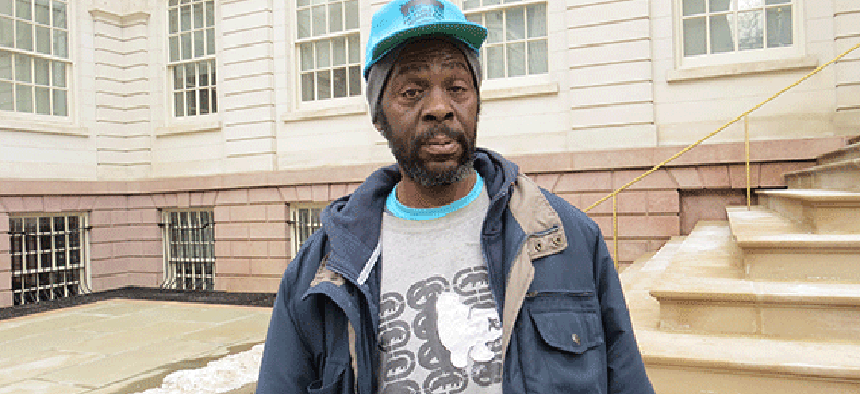Opinion: Who will monitor the homeless shelter monitors?

Photo: Jeff Stein
At a recent City Council hearing, the city Department of Social Services Commissioner Steven Banks told councilmembers that many homeless individuals have come to him with a similar concern. Banks said that many of the thousands of New Yorkers who choose the streets over shelters would finally agree to come inside city shelters if they knew that they would have a private room with a door that they could shut before going to bed. Indeed, while the streets can be a dangerous — and deadly — place, many homeless New Yorkers continue to perceive the shelter system as filled with violence and squalor, and lacking the basic physical privacy protections that should be guaranteed as human rights.
Under Banks’ leadership, the city’s social service agencies have announced dozens of structural and programmatic reforms intended to stem the tide of homeless individuals into the shelter system, and to provide those already in shelters with increased security and privacy. However, one seemingly uncontroversial reform could serve to undermine the larger security and privacy interests of homeless individuals: the installation of video surveillance cameras in hundreds of shelter sites.
If the government intends to monitor one of the most powerless and vulnerable populations in the city, then agencies must be transparent about how surveillance data will be used and shared, and proactive in implementing privacy protection mechanisms. And given the recently enhanced role of the New York Police Department in city homeless services, it is imperative that social services agencies take real action to convince homeless individuals that safety, not harassment, is the sole purpose of their surveillance efforts.
As the New York Times Editorial Board noted in March, allowing NYPD to play a central role in training homeless shelter peace officers and in coordinating outreach to street homeless individuals runs the risk of deterring individuals who “fear police harassment and arrest.” And with NYPD and Department of Sanitation seizures of private property in East Harlem — which prompted calls for “a formal investigation and review of NYPD’s treatment and policing of homeless New Yorkers” from the NYCLU and Center for Constitutional Rights — fresh in the memories of many homeless individuals, can they be blamed for harboring suspicions?
Indeed, there is a deep distrust of NYPD within the homeless community. As one street homeless man from East Harlem, James Doctor, told me after his birth certificate, Social Security card and ID were thrown into the back of a garbage truck, "I see it on the regular – I’m out there every day – how they look down on the homeless. We might as well be dog poop that you stepped in that you’re trying to scrape off of your shoe, because that’s how they look at us.”
And homeless individuals who have had past interactions with the police may be entirely justified in avoiding shelters. Beyond property seizures and orders to vacate public spaces — actions that some advocates have dubbed “the criminalization of homelessness” — NYPD has repeatedly raided and swept through homeless shelters, arresting those suspected of drug crimes.
Expanding video surveillance in shelters could simply exacerbate an already toxic relationship, especially given the incredible technological advances that NYPD currently has at its disposal, like facial recognition capabilities and “a database with millions of faces already stored.” If NYPD sees fit to physically raid shelter sites throughout the city, what would stop them from indiscriminately searching through video surveillance footage, capturing the likenesses of tens of thousands of innocent New Yorkers?
In addition to indiscriminate searches, many of the same privacy concerns that apply to police body cameras are relevant to video surveillance in shelters. As Steven Edwards, a senior policy adviser at the Justice Department, asked in a Washington Post article about body cameras, “Who owns the data? Five years from now, how will this data be used?”
And just as there have been questions raised about the effectiveness and verisimilitude of police body cameras, concerns about the efficaciousness of video surveillance in shelters are valid. As Banks admitted in a letter to state regulators concerning the horrific stabbing of a homeless Staten Island woman and her two children in February, “There was no indication on the video of a dispute that would have alerted security or other residents in the building of a problem.” As in all aspects of life, some tragedies may simply be unavoidable.
With over 1,600 critical incidents in homeless shelters in 2015, city agencies are right to take safety and security seriously. But city agencies must also recognize that many homeless New Yorkers view the city itself as a threat to their security and privacy. Necessarily, agencies must be completely transparent with homeless individuals with respect to how they will be surveilled, how their data will be collected and distributed between government agencies and private security contractors, and what steps will be taken to make sure that innocent — and downtrodden — individuals are not unduly and unfairly monitored.
An important step would be making sure that privacy advocates have a seat at the table with homeless services policymakers. The city is set to create an Interagency Homelessness Accountability Council, which will coordinate homeless services under the direction of Deputy Mayor for Health and Human Services Herminia Palacio; independent civil libertarians and homeless and privacy advocates must be invited to provide a voice for those who are so often left voiceless. City agencies must be forced to recognize that privacy is not simply a room with a door that can be shut; it is a life without unjust surveillance.
